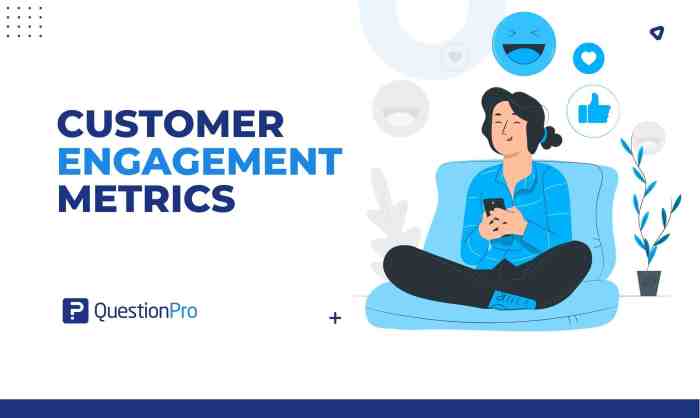Understanding Content Engagement Metrics is crucial for online businesses striving to excel in the digital landscape. By delving into various metrics, brands can optimize their marketing strategies for maximum impact and audience engagement.
Importance of Content Engagement Metrics
Content engagement metrics play a crucial role in the success of online businesses. By analyzing these metrics, companies can gain valuable insights into how their audience interacts with their content, which in turn helps in optimizing digital marketing strategies for better results.
Key Performance Indicators (KPIs)
- Pageviews: This metric indicates how many times a page has been viewed by visitors, giving insights into the popularity of the content.
- Time on Page: Shows the average time visitors spend on a page, helping to understand if the content is engaging enough.
- Click-Through Rate (CTR): Measures the percentage of people who click on a link, providing insights into the effectiveness of calls to action.
- Social Shares: Indicates how many times content has been shared on social media platforms, reflecting audience engagement and brand reach.
Bounce Rate and Conversion Rate
- Bounce Rate: Reflects the percentage of visitors who navigate away from a site after viewing only one page, highlighting the need to improve content relevance and user experience.
- Conversion Rate: Measures the percentage of visitors who complete a desired action, such as making a purchase or signing up for a newsletter, indicating the effectiveness of the content in driving conversions.
Types of Content Engagement Metrics
When it comes to measuring how your audience interacts with your content, there are various types of metrics that can provide valuable insights into their behavior. From likes and shares to bounce rate and time on page, each metric offers a unique perspective on how engaging your content is.
Likes
- Likes are a simple way for your audience to show their appreciation for your content.
- They indicate that your content resonates with your audience and is being well-received.
Shares
- Shares show that your audience finds your content valuable enough to pass it along to others.
- They help increase your content’s reach and engagement, as well as build brand awareness.
Comments
- Comments provide direct feedback from your audience and can spark conversations around your content.
- They offer insights into what your audience likes, dislikes, or wants to see more of.
Bounce Rate
- The bounce rate measures the percentage of visitors who leave your site after viewing only one page.
- A high bounce rate may indicate that your content is not engaging enough or that your website needs improvement in navigation.
Time on Page, Understanding Content Engagement Metrics
- Time on page measures how long visitors spend on a particular page of your website.
- A longer time on page generally indicates that your content is engaging and valuable to your audience.
Leading Metrics vs. Lagging Metrics
- Leading metrics, such as page views and clicks, provide insights into initial audience engagement with your content.
- Lagging metrics, like conversions and sales, reflect the ultimate impact of your content on your business goals.
Interpreting Content Engagement Metrics

When it comes to interpreting content engagement metrics, it’s crucial to dive deep into the data and extract valuable insights that can help improve your content strategy. By understanding audience preferences and behavior, you can tailor your content to better resonate with your target audience. Here are some best practices and tips to help you effectively analyze and interpret these metrics:
Best Practices for Interpreting Content Engagement Metrics
- Look beyond surface-level numbers: Don’t just focus on likes or shares, dig deeper into metrics like time spent on page, bounce rate, and scroll depth to get a more comprehensive view of audience engagement.
- Compare metrics over time: Track changes in engagement metrics over different time periods to identify trends and patterns that can inform your content strategy.
- Segment your audience: Analyze engagement metrics based on different audience segments to understand what resonates with specific groups and tailor your content accordingly.
Tips for Analyzing Metrics to Understand Audience Preferences and Behavior
- Identify top-performing content: Analyze metrics to identify which pieces of content are performing the best and replicate elements that are driving engagement.
- Monitor feedback and comments: Pay attention to audience feedback and comments to understand their preferences, pain points, and interests, which can guide your content creation process.
- Utilize A/B testing: Experiment with different content formats, headlines, and visuals to see what resonates best with your audience and optimize for engagement.
Common Mistakes to Avoid when Interpreting Content Engagement Metrics
- Ignoring context: Don’t analyze metrics in isolation, consider external factors like seasonality, industry trends, or marketing campaigns that could impact engagement.
- Overlooking secondary metrics: Don’t focus solely on one or two metrics, consider a holistic view of engagement metrics to get a comprehensive understanding of audience behavior.
- Relying on vanity metrics: Avoid getting caught up in vanity metrics like page views or likes, instead focus on metrics that provide meaningful insights into audience behavior and preferences.
Improving Content Engagement: Understanding Content Engagement Metrics

When it comes to improving content engagement, analyzing metrics is key. By understanding how your audience interacts with your content, you can tailor your strategies to boost engagement.
Role of A/B Testing
A/B testing plays a crucial role in optimizing content for better engagement. By testing different variations of your content on a sample audience, you can determine which version performs better in terms of engagement metrics such as click-through rates, time spent on page, and social shares.
Successful Strategies by Brands
- Interactive Content: Brands like Buzzfeed and Tasty have found success by creating interactive content such as quizzes and polls that encourage audience participation.
- Personalization: Netflix and Amazon use personalized recommendations based on user behavior to keep their audience engaged and coming back for more.
- Social Media Engagement: Wendy’s Twitter account is known for its witty and engaging responses, which have helped them build a strong and loyal following on social media.
- User-Generated Content: GoPro encourages its users to share their own photos and videos using the product, creating a sense of community and driving engagement.
